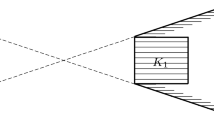Abstract
The segmentation of a function on a set can be considered as the construction of a maximal partial partition of that set with blocks satisfying some criterion for the function. Several order relations on partial partitions are considered in association with types of operators and criteria involved in the segmentation process. We investigate orders for which this maximality of the segmentation partial partition is preserved in compound segmentation with two successive criteria. Finally we consider valuations on partial partitions, that is, strictly isotone functions with positive real values; this gives an alternative approach where the valuation, not the partial partition, should be maximized.
This work received funding from the Agence Nationale de la Recherche, contract ANR-2010-BLAN-0205-01.
Access this chapter
Tax calculation will be finalised at checkout
Purchases are for personal use only
Preview
Unable to display preview. Download preview PDF.
Similar content being viewed by others
References
Meyer, F., Najman, L.: Segmentation, minimum spanning tree and hierarchies. In: Najman, L., Talbot, H. (eds.) Mathematical Morphology: From Theory to Applications, ch. 9, pp. 229–261. ISTE/J. Wiley & Sons (2010)
Najman, L., Schmitt, M.: Geodesic saliency of watershed contours and hierarchical segmentation. IEEE Transactions on Pattern Analysis and Machine Intelligence 18(12), 1163–1173 (1996)
Ronse, C.: Toggles of openings, and a new family of idempotent operators on partially ordered sets. Applicable Algebra in Engineering, Communication and Computing 3, 99–128 (1992)
Ronse, C.: Set-theoretical algebraic approaches to connectivity in continuous or digital spaces. Journal of Mathematical Imaging and Vision 8(1), 41–58 (1998)
Ronse, C.: Partial partitions, partial connections and connective segmentation. Journal of Mathematical Imaging and Vision 32(2), 97–125 (2008), doi:10.1007/s10851-008-0090-5
Ronse, C.: Adjunctions on the lattices of partitions and of partial partitions. Applicable Algebra in Engineering, Communication and Computing 21(5), 343–396 (2010), doi:10.1007/s00200-010-0129-x
Ronse, C.: Idempotent block splitting on partial partitions, I: isotone operators. Order (to appear, 2011)
Ronse, C.: Idempotent block splitting on partial partitions, II: non-isotone operators. Order (to appear, 2011)
Ronse, C., Serra, J.: Algebraic foundations of morphology. In: Najman, L., Talbot, H. (eds.) Mathematical Morphology: From Theory to Applications, ch. 2, pp. 35–80. ISTE/J. Wiley & Sons (2010)
Serra, J.: Mathematical morphology for Boolean lattices. In: Serra, J. (ed.) Image Analysis and Mathematical Morphology. Theoretical Advances, vol. II, ch. 2, pp. 37–58. Academic Press, London (1988)
Serra, J.: Morphological segmentations of colour images. In: Ronse, C., Najman, L., Decencière, E. (eds.) Mathematical Morphology: 40 Years on, Computational Imaging and Vision, vol. 30, pp. 151–176. Springer, Dordrecht (2005)
Serra, J.: A lattice approach to image segmentation. Journal of Mathematical Imaging and Vision 24(1), 83–130 (2006)
Serra, J.: Ordre de la construction et segmentations hiérarchiques. Tech. rep., ESIEE/A2SI/IGM (2010)
Serra, J.: Grain buiding ordering. In: Soille, P., Pesaresi, M., Ouzounis, G.K. (eds.) ISMM 2011. LNCS, vol. 6671, pp. 37–48. Springer, Heidelberg (2011)
Soille, P.: Constrained connectivity for hierarchical image partitioning and simplification. IEEE Transactions on Pattern Analysis and Machine Intelligence 30(7), 1132–1145 (2008)
Author information
Authors and Affiliations
Editor information
Editors and Affiliations
Rights and permissions
Copyright information
© 2011 Springer-Verlag Berlin Heidelberg
About this paper
Cite this paper
Ronse, C. (2011). Orders on Partial Partitions and Maximal Partitioning of Sets. In: Soille, P., Pesaresi, M., Ouzounis, G.K. (eds) Mathematical Morphology and Its Applications to Image and Signal Processing. ISMM 2011. Lecture Notes in Computer Science, vol 6671. Springer, Berlin, Heidelberg. https://doi.org/10.1007/978-3-642-21569-8_5
Download citation
DOI: https://doi.org/10.1007/978-3-642-21569-8_5
Publisher Name: Springer, Berlin, Heidelberg
Print ISBN: 978-3-642-21568-1
Online ISBN: 978-3-642-21569-8
eBook Packages: Computer ScienceComputer Science (R0)



